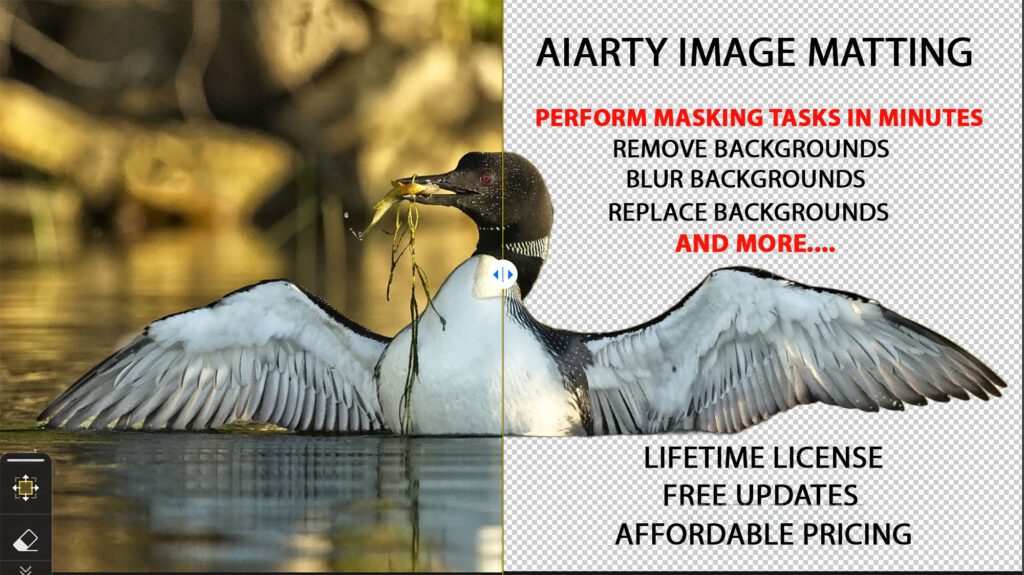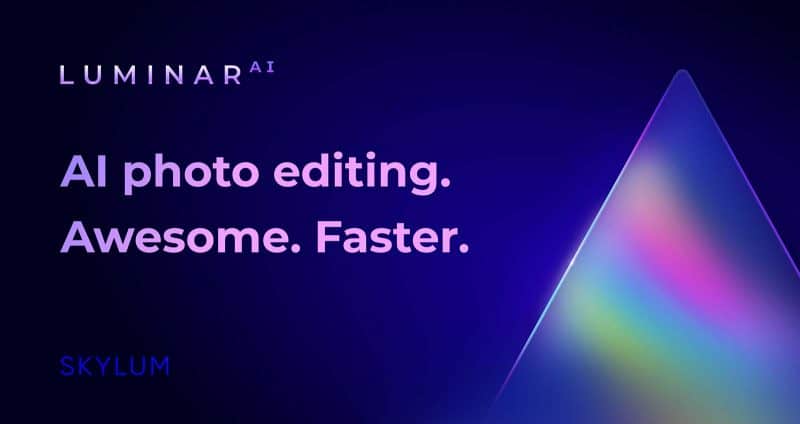Luminar has launched it’s next generation image editor with a fully AI powered version of its image editor with many new features.
A few months back, I wrote a review of Luminar 4. In that time, the company behind the Luminar software, Skylum, has announced plans to release a new software solution that they say will top even the much-beloved Luminar 4. What is it? It’s known as Luminar AI 2020.
What is Luminar AI?
Luminar AI 2020 is an artificial intelligence-driven image editor that can act as a Windows or Mac plug-in or be used on its own. Some of the AI features you can only find in Luminar AI include Atmosphere AI, Iris AI, Body AI, Face AI, and Sky AI.
Skylum states that Luminar AI gives you an experience that “is totally different from any traditional photo editor.” They say the results are instant, and that you can use their software in lieu of a pro photo retoucher.
For those photographers who are results-oriented, problem-solving quality chasers, Skylum indicates that the Luminar AI 2020 is for you.
If you’re hungry to learn more about Luminar AI, then you’re not going to want to miss this review. I’ll discuss all the features to be included with Luminar AI so you can see how this new Skylum software will mesh with your current photo editing workflow.
I’ll even compare Luminar AI to the last iteration of Skylum software, the Luminar 4. If you’re thinking of buying the Luminar 4 but now you’re not sure if you should wait for the Luminar AI, then I encourage you to keep reading. Luminar AI will be out by December 18th, 2020, so you’ll want to decide soon if it’s for you.
I think through this review that you’ll soon see how the Luminar AI 2020 is a fantastic addition to any suite of photo editing software.
The Features of Luminar AI 2020
Incredibly Intuitive Design and Usage
Time is of the essence, and it feels more and more these days like there’s never enough time to get anything done. That’s why it’s so disappointing when you buy a new photo editing software and you have to pour hours of time into watching tutorials and reading detailed instructions just to understand how the software works.
Besides sucking up a lot of your spare time, learning like this can also be a bit boring, if I’m being completely honest. But it’s a crucial step to grasping how the software works and harnessing the most out of it, right?
Not necessarily.
Skylum writes on their website that Luminar AI “may be the world’s first editor that doesn’t require you to watch tutorials.” Its intelligent design and AI framework mean you could be editing photos in Luminar AI the same day you install it, even within the same hour.
This can eliminate the barrier to entry that sometimes plagues beginner photographers. If you’re not sure if you’re going to stick with photography as a hobby, why put hours into learning photo editing software? With Luminar AI, you just load it up and get started.
Use as a Standalone or as a Plug-In
You may have a few old standards you use to polish your photos that you couldn’t imagine discontinuing. I’d bet Photoshop is among them. And hey, if it ain’t broke, then don’t fix it, right?
Like other Luminar iterations, Skylum lets you use Luminar AI the way you want to. If you’d rather it be your standalone photo editor (and that could very well happen considering its awesome features) or you’d rather run Luminar AI as a plugin, that’s your choice. Either way, you get amazing AI-led photo editing capabilities.
Composition AI
As a wildlife photographer, I know a thing or two about composition, or the way your subjects are arranged within the frame when you take a photo. With your camera, you can stand up, kneel down, switch a lens, or zoom to adjust the composition, but what if you’re not happy with the finished product?
You might think there’s no way to go back and fix the image, but then again, you’ve been just introduced to Luminar AI. With the smart Composition AI, you can adjust your image’s composition from a variety of angles so it’s finally just as you envisioned.
Not sure where to start? Don’t worry. Composition AI can take care of the composition for you. To make its changes to your photo, Composition AI relies on a combination of input from the top pro photographers and composition best practices to generate an appealing image every time.
Mood Tool
Mood is one of the best elements in photography, as setting a mood allows you to use your images as the basis of a story. Yet sometimes the mood you get in your photos is not always the one you intended.
With the Mood Tool in Luminar AI 2020, you can establish any mood, from a bright, saccharine one to a darker, more emotional one. The rich variety of color palettes within the Mood Tool are designed for exploring. Try tinkering around to not only find the right emotion you’re going for, but a new style as well.

Supercontrast
Every photo editor has a contrast feature. You don’t even have to pay to get contrast editing anymore, as it’s something you can adjust on your phone or on a free web-based photo editor. With these free options, you can easily get quite garish results if you send the slider bars too far to the left or the right.
Now Supercontrast is here to change the game.

Supercontrast in Luminar AI 2020 is quite appropriately named. You’re not just setting the contrast on the level you would with a paid photo editing software, but you’re using six different controls to adjust all aspects of your photo. From shadows to mid-tones and highlights, you’re now in the driver’s seat to establish the contrast of each part of your photo individually.
Color Harmony
Nature gives us such a beautiful depth of colors, but sadly your camera doesn’t always capture them all in their full glory. To rectify that, you often open your photo editor of choice, set the vibrance and saturation, and bring out all the colors, hopefully without overdoing it on the effects.
Luminar AI’s Color Harmony gives any high-quality vibrance and saturation tool a run for its money. You can refine your color balancing and select the depth of colors to bring out the lovely earth tones of green, the oceanic beauty of blue, and the delicateness of baby pink with Color Harmony.
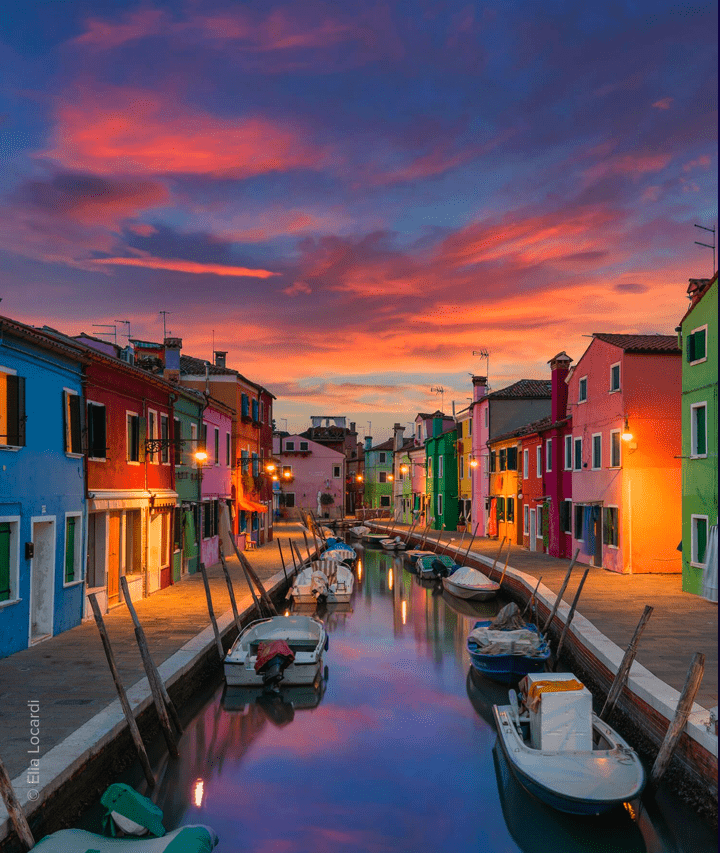
Whether you’re trying to showcase a row of colorful buildings like this image above shows or frame the wonder of a sky at sunrise or sunset, Color Harmony will make your photo look completely different in the best way possible.
Sky AI
Speaking of the sky, it really is one of the best backdrops for photos, huh? Especially in my area of photography, the sky can create such a great atmosphere. You can go to the same place and take the same photo, but the mood of a bright blue sky and that of a dark cloudy sky will transform everything around it.
So too can you manipulate the sky any way you want it with Sky AI in Luminar AI 2020. This smart feature lets you select the type of atmosphere you want to go for, then Sky AI will do the rest. That includes adjusting your photo’s colors and lighting to better match the new sky. Your cloudy, post-storm sky will impart darkness on your subjects while a starry nighttime sky will cast a dim glow.
Is the sky in the photo you took full of details like birds or falling snow? Sky AI can differentiate between what is and isn’t the sky, leaving items in the sky intact.

Structure AI
You tried to focus your camera as much as you could, yet some of your photo details turned out a little fuzzy. A traditional sharpener can do too much, making your image look pencil-drawn in areas.
With Structure AI, you can impart detail in a stunningly natural way with the addition of clarity and depth. Whether you photograph objects, skies, water, or people, Structure AI can intelligently sharpen them all.
Atmosphere AI
When I first got started in photography, if you wanted a rainy backdrop for your photos, you had to stay outside and hope for rain (maybe a little rain dance would help). If you wanted snow, you had to withstand freezing temperatures.
These days, you can skip all the uncomfortable inclement weather and add effects using Atmosphere AI. As the name tells you, this feature in Luminar AI 2020 can create drizzle, steam, haze, mist, fog, and other natural elements while you’re cozy at home.
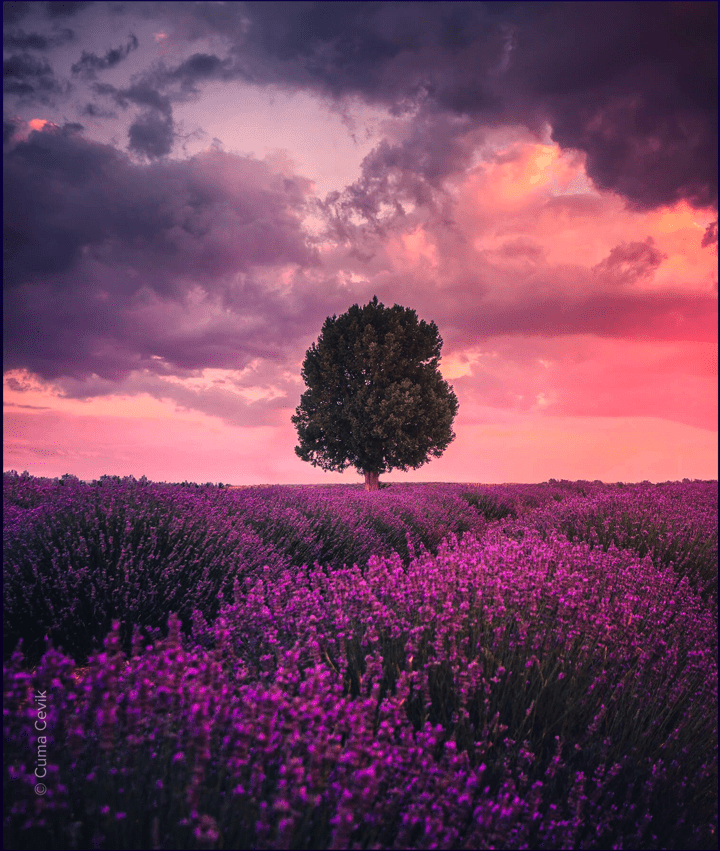
Even better if you don’t need to mask the elements you want and then paste them in there. Atmosphere AI uses natural-looking effects that also don’t stack layer upon layer on your image.
Bokeh AI
Picture this: it’s a hazy day out, the kind that’s really augmented by one of your top-quality lenses. The only problem is that, while you brought your camera with you, you left that particular lens at home. You’re all out of luck, right?
Not at all. With Bokeh AI, you can add natural-looking haze to the background of any image to make your subject that much more distinct.
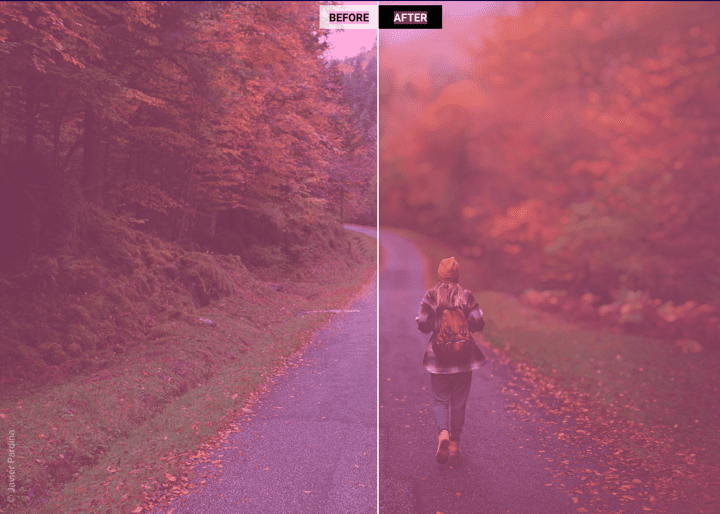
Accent AI
Now we’re getting into some of the really cool stuff that Luminar AI 2020 can do. For example, in the Accent AI tool, you get a single magic slider you can use to set the color and lighting of your image.
Unlike most sliders, Accent AI doesn’t transform your photo into an overdone nightmare if you set the slider too far one way. It’s an AI magic slider, so all your results turn out very natural.
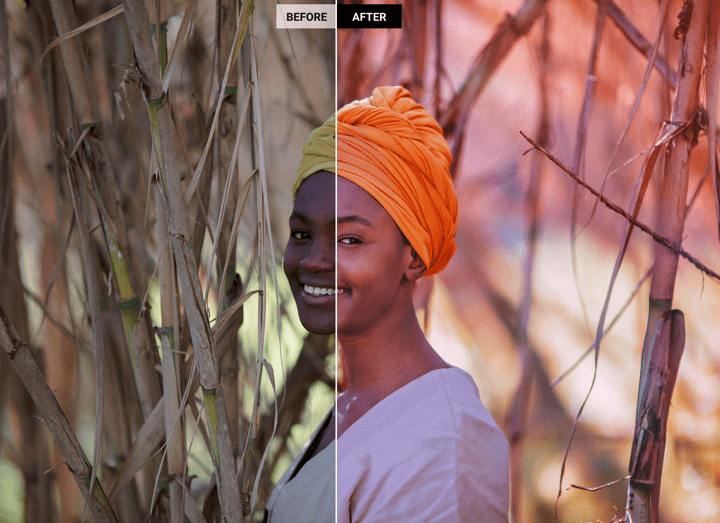
Skin AI
Even I was impressed with this feature, and I focus on photographing animals, not people. Skin AI will clean up skin blemishes like they’re nothing, but only blemishes. The subject’s hair will remain untouched. Even more intelligent is how Skin AI can differentiate between blemishes versus normal skin texture, leaving the texture in place. Your photo subject’s pores will remain too!
Face AI
If you’d rather do a little bit more editing with your portrait photography, Face AI is the next step. This tackles more than just skin blemishes, but dark circles, teeth yellowing, and other features that most of us would rather be edited out of our photos.
The natural enhancements that Luminar AI 2020 deposits along the way prevent the overblown and obvious Photoshopping effects to your portraits. Your subject still looks like themselves, but an even better version of themselves.
Iris AI
If you’d rather finetune just the eyes of your subject, you’ll appreciate the Iris AI feature. Eyes are the window to the soul, and that goes when photographing people and animals alike.
In Iris AI, you can add more expression to a subject’s eyes, giving them a more lifelike look that instantly makes your photo more classic.
Body AI
The last intelligent feature in Luminar AI 2020 is Body AI. Unsurprisingly, you can slim down bodies, but here’s a new one: you can add more weight too. This isn’t done through some cartoony body slider either, but realistic and natural measures.
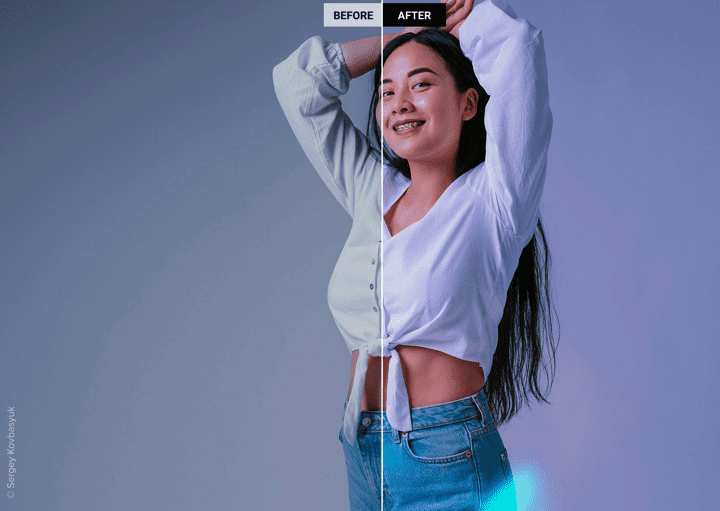
Luminar AI vs. Luminar 4: Which Is Better?
Since Luminar AI will follow on the heels of Luminar 4, I next wanted to take a look at both Skylum software options and do a bit of comparing of features to encourage you to choose the best one.
Sharpening
Luminar 4 has a feature called Detail Enhancement intended to sharpen images and bring back their lost detail. You can adjust the sliders numerically for precise editing, but at the end of the day, Luminar 4 still has a sharpener. Here’s what I mean.
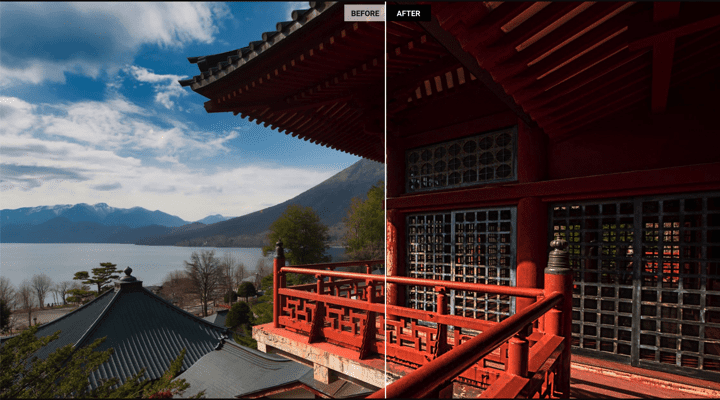
Luminar AI’s Structure AI adds sharpening and detail to the parts of the images that need it in what I would call a much more natural way.
Landscape Enhancing
Luminar 4’s Landscape Enhancer is very impressive, don’t get me wrong. You can edit via sliders like Foliage Enhancer, Golden Hour, and Dehaze. The results you get are pretty stunning too, just not quite as much as when you look at Luminar AI’s Atmosphere AI and Sky AI.
These two intelligent features are really like a one-two punch in photo editing. Atmosphere AI can add haze, birds, golden rays of sun, or whatever would best enhance your photo. Sky AI lets you play the role of god, or at least the weatherperson as you influence the skies. It’s smarter than the AI Sky Replacement Tool found in Luminar 4 by a pretty good margin.
Oh, and the Golden Hour slider, while great, lacks the depth you can get with the Color Harmony tool in Luminar AI 2020.
Contrast
This one is admittedly a bit of a narrower of a victory for Luminar AI, because I still quite really do like the Smart Contrast Tool included with Luminar 4. It can tell the difference between areas of your photo that need more contrast and those that need less and then apply them.
However, the Smart Contrast Tool doesn’t use AI, so I wouldn’t say the results are necessarily as well-thought-out as what you get with Supercontrast. Does the Smart Contrast Tool use six different controls for contrast like Supercontrast does? I didn’t think so.
AI Structure
If an AI-driven structure tool seemed familiar to you, that’s because Luminar 4 featured AI Structure, one of several AI tools in Luminar 4. This isn’t quite the same tool though, and whatever advancements the original AI Structure had in Luminar 4, Skylum ran with it in Luminar AI 2020, bringing us the vastly superior Structure AI feature.
Natural Light
The last area I want to touch on is the difference in lighting features found in Luminar 4 and Luminar AI 2020.
Luminar 4 features the AI Sky Replacement Tool, like I said, and within that is the Sunrays feature. This feature lets you add rays of sun here and there across your photo for a natural sunny effect. You’re free to adjust how much sun the image has as well as the length of the sunrays.

Do I think Sunrays is still a good feature? I do, but I don’t think it quite has as natural an effect as what you’d find in Luminar AI 2020. Again, the Atmosphere AI tool can introduce just the right light that your image calls for, as can Sky AI.
Don’t forget Accent AI, another AI tool in Luminar AI 2020 for introducing natural-looking light as well as color. I just don’t think Sunrays as a feature can compare.
Luminar AI 2020 Pricing
Okay, I’ve definitely piqued your interest, so how much does Luminar AI 2020 cost?
For single-seat use, Luminar AI is $74, and for two seats, it’s $99. You may also opt to add a Luminar X membership for $99 a year, which includes exclusive Sky and Looks packs as well as tutorials, lessons, and discounts.
Also available with your purchase is Aurora HDR, a high dynamic range photo editor that blends AI with a Quantum HDR EngineTM for better rendering of mid-ranges, highlights, and shadows, even if you’re shooting in RAW.
The Photographic Storytelling with Luminar is another extra you can tack on to your purchase for $109. This includes a video course on improving your photography game.
Those extras are all optional, so it’s no sweat if you don’t want them. Skylum does recommend them as part of your Luminar AI purchase to get the most out of your Luminar software.
Although Luminar AI isn’t out for several more months, you can preorder your copy now and they are offering an early bird discount for those who act before the release. If you’re one of the first 30,000 people to buy Luminar AI before it’s out, you’re considered an early bird. According to Skylum, early birds get the app first, get a pre-order discount and they can become part of the Luminar AI Insider program. This “private community” of early customers earns surprises, special event access, and exclusive tutorials. You can pre-order Luminar AI 2020 by following this link.
Luminar AI 2020 FAQs
Still curious about some more facets of Skylum’s Luminar AI 2020? You won’t be for long. I curated a few commonly asked questions about the software that I think you’ll quite appreciate.
What Hardware Does Luminar AI Run On?
If you’re a Windows user, you need a PC with an AMD Ryzen 5 or an Intel Core i5 CPU or better to run Luminar AI. You should also have up to 8 gigabytes of RAM at least, with 16 GB Skylum’s own recommendation. Your graphics card should be an Open GL 3.3 or a more up-to-date model.
The most important part of your operating system that you need to use Luminar AI 2020 is Windows 10, as Luminar AI is not supported for Windows 7 or even Windows 8.1. You should have a display of 1280×768 as well.
If you’re a Mac user, you need a Mac from at least 2010, including the Mac Mini, Mac Pro, iMac Pro, iMac, MacBook Pro, the MacBook Air, or the MacBook. The Mac must run macOS 10.13.6 or later editions, as Luminar AI is not supported on macOS 10.12.
Your computer should have an Intel Core i5 CPU or something better, with between 8 and 16 GB of RAM. If you have 10 GB free on your hard disk, that’s good, and SSD is even better. You also need a display resolution of 1280×768 or bigger.
When macOS Big Sur comes out in the fall, Skylum anticipates compatibility with Luminar AI.
How Does Luminar AI’s Artificial Intelligence Work?
According to Skylum, they “use deep convolutional neural networks” and top-line research when creating their artificial intelligence. What? Press one for English. I think what they mean is the software has algorithms built in that analyze each image and help you to apply the best rendering possible based on the thousands of models that the AI has been trained out with.
Are All Features in Luminar AI Automated?
AI does not mean Luminar AI will do everything for you automatically. Skylum explains that the first time you run Luminar AI, you can select from one of three modes: use the options as they are, use sliders for template editing, and use the edit button to check which tools are running. In the editing toolset, you have the freedom to switch between certain tools, turning them on or off.
Does Luminar AI replace Luminar 4?
Yes – Luminar AI is a newer version of Luminar 4 and with its AI build it will be vastly superior.
Does Luminar AI process RAW files?
Yes – Luminar AI will processes both RAW and JPEG files.
Is Luminar non destructive?
Yes – it is a non destructive RAW image editing software which allows you to edit the RAW file and save to Tiff, JPEG, etc.
Can Luminar AI Be My Only Image Editor?
Yes – Luminar was designed as a stand alone product or a plugin. I find it easier to use than Photoshop and Lightroom and it has no monthly subscription.
Conclusion
Luminar AI 2020 is the latest innovation from Skylum, also the makers of Luminar 4. While not a direct sequel to Luminar 4, Luminar AI does improve upon a lot of the features found in Luminar 4. You can create more realistic natural effects with Sky AI and Atmosphere AI, adjust the lighting through Accent AI and the Mood Tool, and use Color Harmony and Supercontrast for more intelligent versions of your average photo editing tools.
Even if you do more portrait photography than wildlife photography, there’s a lot here for you too in Luminar AI. Skin AI and Face AI let you bring out the best in your subject’s face, Iris AI is for introducing more lifelike qualities to eyes, and Body AI can add or remove weight depending on what suits your subject best.
If you want to get on the Luminar AI Insider program, I advise you to buy Luminar AI 2020 on preorder now. Even if you miss that early bird special, you’ll still want Luminar AI as part of your photo editing arsenal if you want to make dramatic changes to your images with the power of artificial intelligence.
